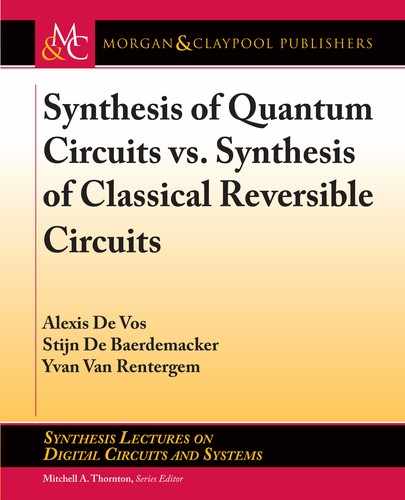
4.6. EXAMPLES 75
One can verify that both (4.11) and (4.12) satisfy AA
D BB
D CC
D DD
D I , such that
A, B, C , and D are all unitary. Finally, one may check that
A.I
C
C /
D
2 U
11
B.I C / D 2 U
21
A.I C /D D 2 U
12
B.I C C /D D 2 U
22
;
such that (4.3) is fulfilled. Finally, the reader will easily verify that, for n D 2, the expressions
(4.11) recover the formulae (3.7), and expressions (4.12) recover the formulae (3.8).
We now investigate in more detail the dual decomposition of Section 4.4. Because we
have two matrix sets fa; b; c; d g, we obtain two sets fA
0
; B
0
; C
0
; D
0
g :
A
0
D .Q
21
i Q
22
/W
21
W
11
.Q
11
i Q
12
/
B
0
D .Q
11
C i Q
12
/W
11
C
0
D .Q
11
i Q
12
/W
11
D
0
D i W
11
W
12
(4.13)
and
A
0
D .Q
21
C i Q
22
/W
21
W
11
.Q
11
C i Q
12
/
B
0
D .Q
11
i Q
12
/W
11
C
0
D .Q
11
C i Q
12
/W
11
D
0
D i W
11
W
12
;
respectively. Here, Q
jk
W
jk
are the polar decompositions of the four blocks u
jk
constituting the
matrix u D GUG.
4.6 EXAMPLES
As an example, we synthesize here the two-qubit circuit realizing the unitary transformation
1
12
0
B
B
@
8 0 4 C 8i 0
2 C i 3 9i 2i 3 6i
1 7i 6 6 C2i 3 C3i
3 C 4i 3 3i 2 4i 9i
1
C
C
A
:
We perform the algorithm of Section 4.5, applying Hero’s iterative method (see Appendix A)
for performing the four polar decompositions [64]. Using ten iterations for each Hero decom-
position, we thus obtain the following two numerical results:
A D
0:67 C 0:72i 0:19 C 0:03i
0:18 C 0:06i 0:80 0:57i
; B D
0:33 0:64i 0:50 0:47i
0:69 C 0:00i 0:20 0:70i
;

76 4. TOP
C D
0:04 0:95i 0:01 0:30i
0:07 C 0:29i 0:25 0:92i
; and D D
0:87 0:43i 0:15 C 0:20i
0:08 0:24i 0:68 0:68i
and
A D
0:67 0:72i 0:19 0:03i
0:16 C 0:10i 0:30 0:93i
; B D
0:50 0:52i 0:50 C 0:47i
0:19 C 0:66i 0:70 C 0:20i
;
C D
0:04 C 0:95i 0:07 0:29i
0:01 C 0:30i 0:25 C0:92i
; and D D
0:87 C 0:43i 0:15 0:20i
0:08 C 0:24i 0:68 C 0:68i
:
In Chapter 2, we investigated the synthesis of all 24 classical reversible two-bit circuits as
well as all 40,320 classical reversible three-bit circuits. We investigated the statistics of the gate
cost of the resulting gate cascades. Here, we cannot synthesize all 2-qubit or 3-qubit circuits,
for the simple reason there are an infinite number of them. e best we can do is generate,
for example, 1,000 random U(4) or U(8) matrices [56, 65] and synthesize the corresponding
quantum circuits. However, we can predict that all these circuits will have a same gate cost.
Indeed, as explained in Section 4.2, the resulting schematic consists of
5
12
4
w
2
3
(un)controlled
U(2) gates.
Because there exist only two different P(2) blocks, there is one chance out of two such
a block equals the IDENTITY block. In contrast, because there exist 1
4
different U(2) blocks,
the probability it equals the
IDENTITY
block is negligible. Hence, none of the 1,000 circuits
will contain a controlled IDENTITY gate that would lead to a cost reduction. Hence, all 2-qubit
circuits will have quantum-gate cost equal to 6, and all 3-qubit circuits will have quantum-gate
cost equal to 26. Decomposition of each U(2) block into two XU(2) and three ZU(2) blocks
(see Section 3.3) does not alter the conclusion: the odds that a NEGATOR gate or a PHASOR gate
equals the IDENTITY gate are 1 to 1
1
.
In contrast to the numerical approach in the above first example, we will now perform an
analytic decomposition of a second example:
U D
0
B
B
@
1
cos.t/ sin.t/
sin.t/ cos.t /
1
1
C
C
A
;
i.e., a typical evolution matrix for spin-spin interaction, often discussed in physics. We have the
following four matrix blocks and their polar decompositions
1
:
1
In fact, the presented polar decompositions are only valid if 0 t =2 (i.e., if both c 0 and s 0). However, the
reader can easily treat the three other cases.
..................Content has been hidden....................
You can't read the all page of ebook, please click here login for view all page.
